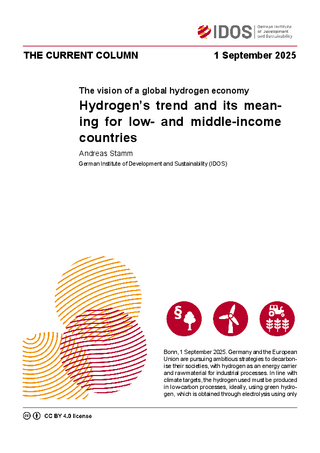The vision of a global hydrogen economy
Hydrogen’s trend and its meaning for low- and middle-income countries
Stamm, AndreasThe Current Column (2025)
Bonn: German Institute of Development and Sustainability (IDOS), The Current Column of 1 September 2025
Bonn, 1 September 2025. Germany and the European Union are pursuing ambitious strategies to decarbonise their societies, with hydrogen as an energy carrier and raw material for industrial processes. In line with climate targets, the hydrogen used must be produced in low-carbon processes, ideally, using green hydrogen, which is obtained through electrolysis using only renewable energies. In the long time prevailing optimistic discourse, the global supply of energy sources would no longer be tied to existing oil, gas or coal reserves. Instead, hydrogen could be produced wherever there is good potential for wind, solar or geothermal energy. This might open up new opportunities for low- and middle income countries. The targets set out in the hydrogen strategies are ambitious. In the hydrogen strategy from 2023, Germany anticipates an electrolyser capacity of 10 GW for 2030. As this would not be sufficient to produce the required quantities of H2, imports might cover 50% to 70% of total hydrogen demand.
Five years after the publication of the hydrogen strategies, euphoria has given way to disappointment. In Germany, only 170 MW of electrolysis capacity had been installed by the first quarter of 2025, and the target of 10 GW by 2030 is no longer considered achievable. From an international perspective, the situation is no better. According to the International Energy Agency, only about 7% of all global hydrogen projects have currently undergone a final investment decision and are therefore likely to be implemented.
In recent months, there have been numerous reports of cancelled H2 projects. This affects all elements of the supply chain: In July 2025, the Spanish energy company REPSOL halted a 200 MW project at a refinery in Puertollano, one of the largest planned H2 projects in Europe. Months earlier, Equinor (Norway) and RWE (Germany) had suspended their joint plans for a hydrogen pipeline through the North Sea. This pipeline would have enabled a reliable supply of hydrogen to industrial customers in Germany and Europe. Recently, the world's second-largest steel producer, ArcelorMittal, rejected an offer from the German government to receive more than one billion euros in subsidies for the decarbonisation of two steel plants. They see the long-term supply of hydrogen as uncertain and fear that green technologies will put them at a competitive disadvantage against international competitors.
There are many reasons for the structural crisis in the expansion of the hydrogen economy. It is worrying that the companies involved are not only citing soft factors (such as unclear regulations) that could quickly be overcome with the appropriate political will. Rather, they argue with the economic fundamentals of hydrogen value chains: hydrogen is still significantly more expensive than fossil fuels such as natural gas. Potential customers are unwilling or unable to pay significantly higher prices for hydrogen than for less climate-friendly alternatives. In addition, several elements of the hydrogen supply chains are not yet technologically mature, such as ammonia cracking to enable the transport of H2 in the form of a more suitable derivative. Despite all these difficulties, we assume that H2 has a future and that a hydrogen market will develop, once the implementation gap can be overcome.
Most countries feel bound by their climate protection commitments, and some sectors can hardly be decarbonised without hydrogen as an energy carrier or raw material. In addition, applied technical research continues with the potential to put the hydrogen ramp-up back on the agenda.
How should low- and middle-income countries and international cooperation respond to the current ‘hydrogen limbo’? A „wait-and-see attitude“ would unnecessarily cost time. We propose continuing the implementation of H2 projects, focusing on H2-based solutions to sustainable development challenges. Two examples: 1) Hydrogen can be used to decarbonise the fertiliser industry. Decentralised fertiliser production based on low-emission hydrogen can support food security in Africa, reduce greenhouse gas emissions and contribute to the further maturation of hydrogen technologies. 2) As an alternative to electrolysis, hydrogen can be obtained from wastewater, e.g. through fermentation. This can reduce environmental pollution (e.g. eutrophication of water bodies) and health risks associated with urban wastewater.
When different development goals are pursued simultaneously, the cost differences between hydrogen and conventional technologies become less significant. These solutions should be developed in research partnerships with the Global South as an important part of a multilateral hydrogen strategy to address global challenges.


